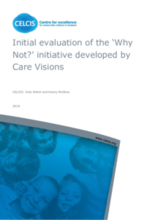Introduction
This short document provides a summary of initial learning from data gathered for an evaluation of the Why Not? initiative. The study was commissioned by the social care organisation Care Visions. The document should be read alongside the literature review entitled In and beyond the care setting: relationships between young people and care workers. The review summarises key findings from literature and policy that are relevant to the concept and delivery of the Why Not? initiative.
Care Visions was established in Scotland in 1998 to provide specialist residential care for children in small group homes. The provision is based on a therapeutic model termed the ‘Sanctuary Model’ (www.carevisionsresidential.co.uk/the-sanctuary-model). The organisation has since expanded, and now comprises 30 small residential services across Scotland and fostering services in Scotland and Ireland for 175 young people, as well as home care services in the North East of England, and dementia services in China.
The Why Not? initiative within Care Visions services was started in 2014 to ‘improve the way young people are supported when ageing out of care, by offering a different experience of relationships beyond care’ (www.carevisionsresidential.co.uk/why-not/). The aim of the scheme was to offer every young person leaving a Care Visions service a meaningful connection to a supportive adult, based on a relationship that has developed within the care setting and that is valued by the young person. The intention was that this relationship continues throughout the young person’s transition from care and into adulthood. The stated aims were to reduce the sense of isolation and loneliness that is so often a feature of leaving care, and provide continuity of relationships at a time of change and disruption (Duncalf, 2010; Morgan & Lindsay, 2006; Stein, 2012a, 2012b). Relationships encompassed by the Why Not? initiative were to be open-ended, informal, ‘natural’, supportive relationships that endure over time.
The ‘Why Not?’ initiative was inspired by a model that emerged in New York in the mid 1990’s, following concerns about the disproportionate number of homeless adults who had previously been in foster care. Pat O’Brien developed a programme in response to this issue that became the ‘You Gotta Believe’ movement (www.yougottabelieve.org). At the heart of the programme was the belief that no young person is ‘unadoptable’, such that the programme concentrates on finding permanent families for older children and young adults in foster care. You Gotta Believe has a particular focus on young people aged 16-21, and seeks to recruit substitute families based on the idea of ‘moral adoption’. The concept of ‘moral adoption’ is an acknowledgement that, for many young people in long-term care, legal adoption is not appropriate, but they can be offered an ‘unconditional, lifetime commitment’ from a substitute parent figure (www.yougottabelieve.org/parenting/what-is-adoption/). This model was the starting inspiration for the Why Not? model, inspiring the aim of potentially life-long connections where parties would experience a genuine sense of commitment and concern for each other.

